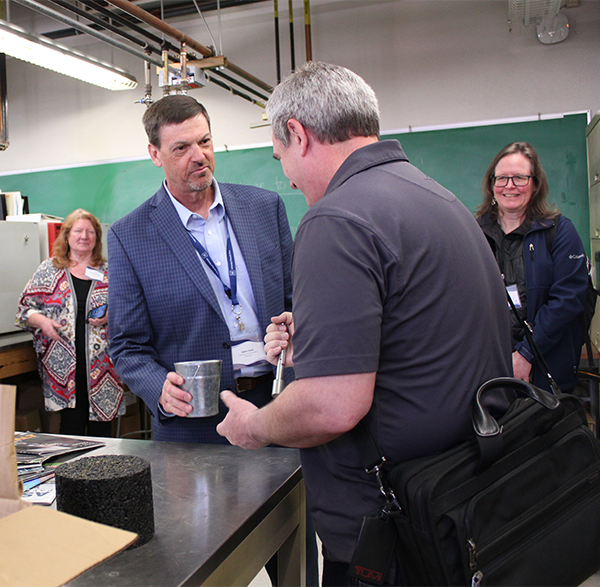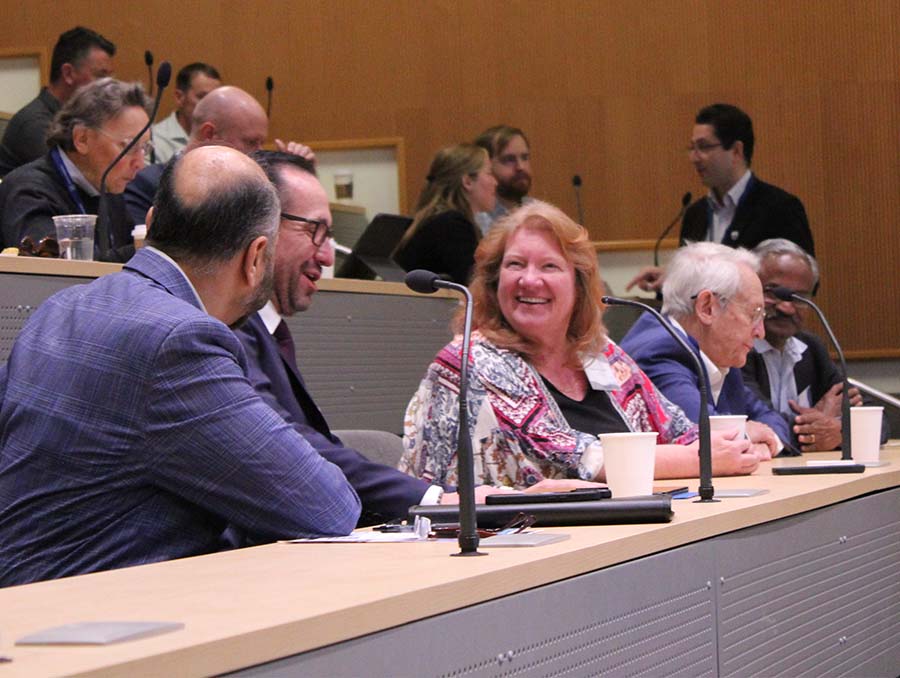Faculty and students in the Civil & Environmental Engineering (CEE) Department showcased traffic timing, structural testing and other infrastructure research during the Infrastructure Forum on March 18 at the University. About 85 infrastructure sector leaders, mostly from public agencies such as the Nevada and California departments of transportation, cities and counties, attended the event. Lab tours and discussions were part of the agenda, and students displayed project posters at the event designed to build relationships between industry and the University.
“You should be expecting world-class facilities from us, and that’s what we’re going to show you,” Krishna Pagilla, CEE chair, told the audience.

Those facilities include the Center for Civil Engineering Earthquake Research, home of two state-of-the-art earthquake engineering facilities, one of which houses the unique Large-Scale Laminar Soil Box System; the Western Regional Superpave Center, one of five centers established by the Federal Highway Administration to promote the Superpave technology — a system of components that work together to provide superior performing asphalt technology; and the Nevada Water Innovation Institute, a university-industry collaborative partnership to drive innovation in the water sector. These facilities collaborate with industry to advance technologies.
Forum attendees were also able to tour the environmental engineering labs, which focus on water quality analysis and other water-related research, including research on polyfluoroalkyl substances or PFAS — also known as “forever chemicals,” because they remain in the environment for long periods of time.
Also showcased was the Center for Advanced Transportation Engineering Research, which studies traffic control systems, including the use of LiDAR sensors to develop smarter, safer transportation infrastructure; and geotechnical engineering lab, which researches complex stress path testing of soils, crucial to the design of dams, foundations, retaining walls and other underground projects.
'Infrastructure is crucial’
Before touring those labs, event attendees heard from Tracy Larkin Thomason, Nevada Department of Transportation (NDOT) director; Bob Lucey, state of Nevada Infrastructure Coordinator; and Sudhakar Vatti, California Department of Transportation (CalTrans) deputy division chief.
Thomason, who holds a Bachelor of Science in civil engineering and a Master of Business Administration from the University of Nevada, Reno, emphasized that infrastructure is the foundation for many functions of society. With experience ranging from transportation and maintenance engineering to planning, Thomason noted that all those civil engineering sub-disciplines contribute to strengthen overall infrastructure. One of her current interests, incorporating digital infrastructure into transportation, also has the potential to strengthen transportation infrastructure. It’s also the basis for one of her projects: laying the groundwork for digital infrastructure along Interstate-80, from California to New Jersey.
“Nevada is getting to be bigger than just Nevada,” Thomason said, adding that such digital infrastructure could help solve issues of how traffic gets in and out of Nevada, as well as growth within the state.
Bob Lucey, another University graduate and the chair of Gov. Lombardo’s working committee on Infrastructure and Transportation, emphasized the importance of infrastructure — and the civil and environmental engineers who build that infrastructure — to business and industry.
“Infrastructure is crucial — it is the catalyst to a successful business,” Lucey said, in his address to the forum. “It is the individuals who sit in this room who deliver that infrastructure.”
Bridges are one aspect of that infrastructure, and the area of focus for Sudhakar Vatti at CalTrans. He spoke about the role infrastructure can play in public safety and touched on past collaborations with engineering professors Ian Buckle, Sheriff Elfass and Keri Ryan.
















